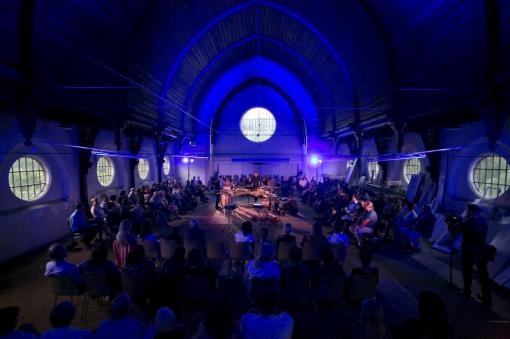In its twenty-seven years of existence, the Concentus Moraviae International Music Festival has been held in a number of unusual and unique places. Sunday's program Homo Sapiens – The Story of Rhythm in Velké Meziříčí has the potential to be one of the most memorable concerts of the festival. On June 5, OK Percussion Duo musicians Martin Opršál and Martin Kleibl, together with guests and students Tomáš Javora and Kryštof Vašíček performed in the normally inaccessible premises of the New Synagogue, which has served as a center of affordable shopping for years. The concert was held in cooperation with the European Festival of Philosophy, the Jewish Community of Brno, and the town of Velké Meziříčí. At the same time, it was part of the project From the Shopping Center to the Cultural Community.
The festival day also included an early evening public debate at the Jupiter Club in Meziříčí on the topic of “Transformations of Extraordinary Buildings and Their Impact on the Life of the City”, which was opened by the mayor of the municipality Alexandros Kaminaras and moderated by publicist and dramaturge Boris Klepal. The debate was also attended by Táňa Pelíšková, vice-president of the Jewish Community of Brno, Eva Kočí Valová, educator and driver of the city's cultural life, dramaturge Viktoria Knotková, head of the Projects of Public Space and Competitions Department at the Brno City Architect's Office Michal Doležel, and architect and educator Jaroslav Sedlák. Although there were a number of conflicting points of view, ideas, and suggestions on the direction the new function of the synagogue should take during the almost two-hour debate, the main result was clear – the current situation needs to be changed. The Concentus Moraviae Festival concert under review thus became the first clear step towards a more dignified fate for the temple.
The entrance to the synagogue itself was a bit like falling down the rabbit hole from Alice in Wonderland – amongst the underwear, shoes, and drinks, one walked to a staircase that partially acted as a storage area for un-displayed goods. Once one ascended to the hall itself, however, one could hardly hold back the unadulterated amazement. Ornate beams lined the long nave of the temple, with the fading light of late afternoon streaming in through the round windows. This place needed no preparation – the magical atmosphere was an integral part of the space, and had only been waiting for years for someone to come along and give it meaning.
The musical line-up consisted of a rich selection of composers, including Johann Sebastian Bach and Claude Debussy, but also Ástor Piazzolla and Steve Reich. The performers sought to create an imaginary story of sound and rhythm from the roots to the future. The opening piece was the movement Crystalline from Jacob Druckman's meditative Reflections on the Nature of Water for solo marimba. The interpretation was sensitively handled by Martin Opršál, whose delicate work with dynamics and beats facilitated all the fast figurations and runs, but especially the tense silence that separated these segments. Martin Kleibl continued the theme of primordial human rhythms and primitive instruments with an improvisation based on the Homeric hymn On Earth the Mother of All which incorporated stones and rattles. The theme of indigenous rhythms was reinforced by minimalist Steve Reich's Clapping Music, in which the two performers joined forces for the first time. The following Ghanaia by Matthias Schmitt introduced the listener to a different musical world. Although it started quite slowly and minimalistically, its middle section featured fresh blues musical techniques.
The set dramatic trajectory from the original rhythms of nature to a purely human musical culture was enhanced by Allemande from Johann Sebastian Bach's original Cello Suite No. 6. It should be added that the marimba did not detract from Bach's work in the slightest, and the resulting fusion was a kind of “ethereal counterpoint” thanks to its soft sound (with slight exaggeration). On the other hand, Piazzolla's Libertango, arranged by Eric Sammut and Martin Kleibl, with its extensive use of the drum kit, became a fitting contrast to the rather restrained Bach.
Debussy's Clair de lune (arr. Martin Opršál) became the first piece for which the OK Percussion Duo invited the first of its students. The pair of marimbas performed by Martin Opršál and Tomáš Javora subsequently pushed Debussy's piece to even greater dreaminess and hypnoticism. Student and teacher were well matched and interacted well even with changes in tempo or dynamics. The calm atmosphere was then stirred up by the OK Percussion Duo's original creation in the form of Snares Rock'n'Roll, in which Martin Kleibl and Kryštof Vašíček managed not only to achieve typical rock'n'roll rhythms, but also to change the pitch of the tone with the help of pushing the elbow on the snare drum head. A melody was born, one similar to Perkins' Blue Suede Shoes. The four musicians then joined forces for the rhythmically rocking final piece of the evening, Birdland (arr. Martin Opršál) by composer Joe Zawinul, a jazzman with roots in South Moravia.
The concert, subtitled Homo Sapiens – The Story of Rhythm, presented the sounds and rhythms that make up not only human music, but also the eternal music of nature. At the same time, however, it also reopened a space that has been dormant for many years and which certainly deserves more than it is currently getting. One can only hope that the synagogue will see a more noble fate and that at least one of the many interesting proposals made during the afternoon debate will come to fruition. The former temple and the people of Velké Meziříčí deserve nothing less.
OK Percussion Duo
Martin Opršál, Martin Kleibl / percussion
Program:
Homo Sapiens – The Story of Rhythm
Velké Meziříčí, New Synagogue
Sunday, June 5, 2022, 20:00
































No comment added yet..